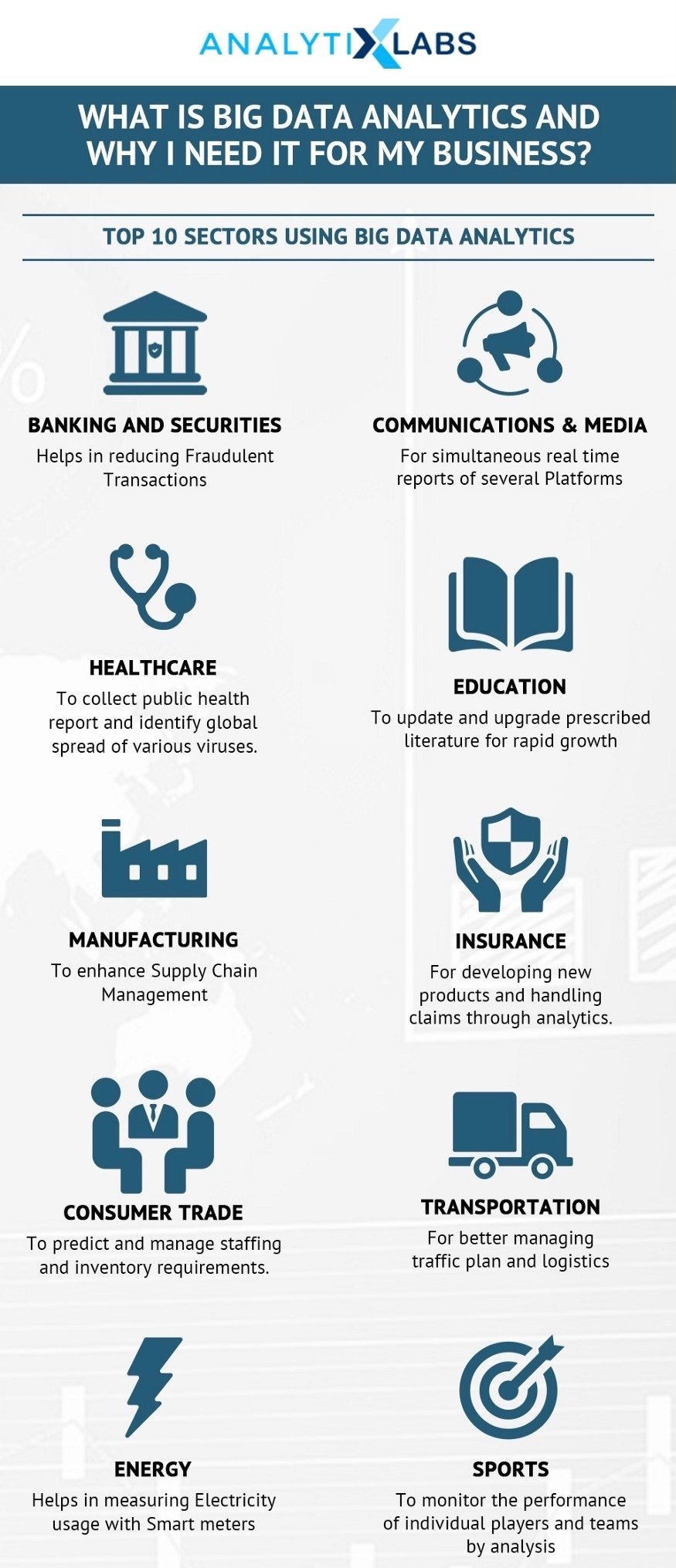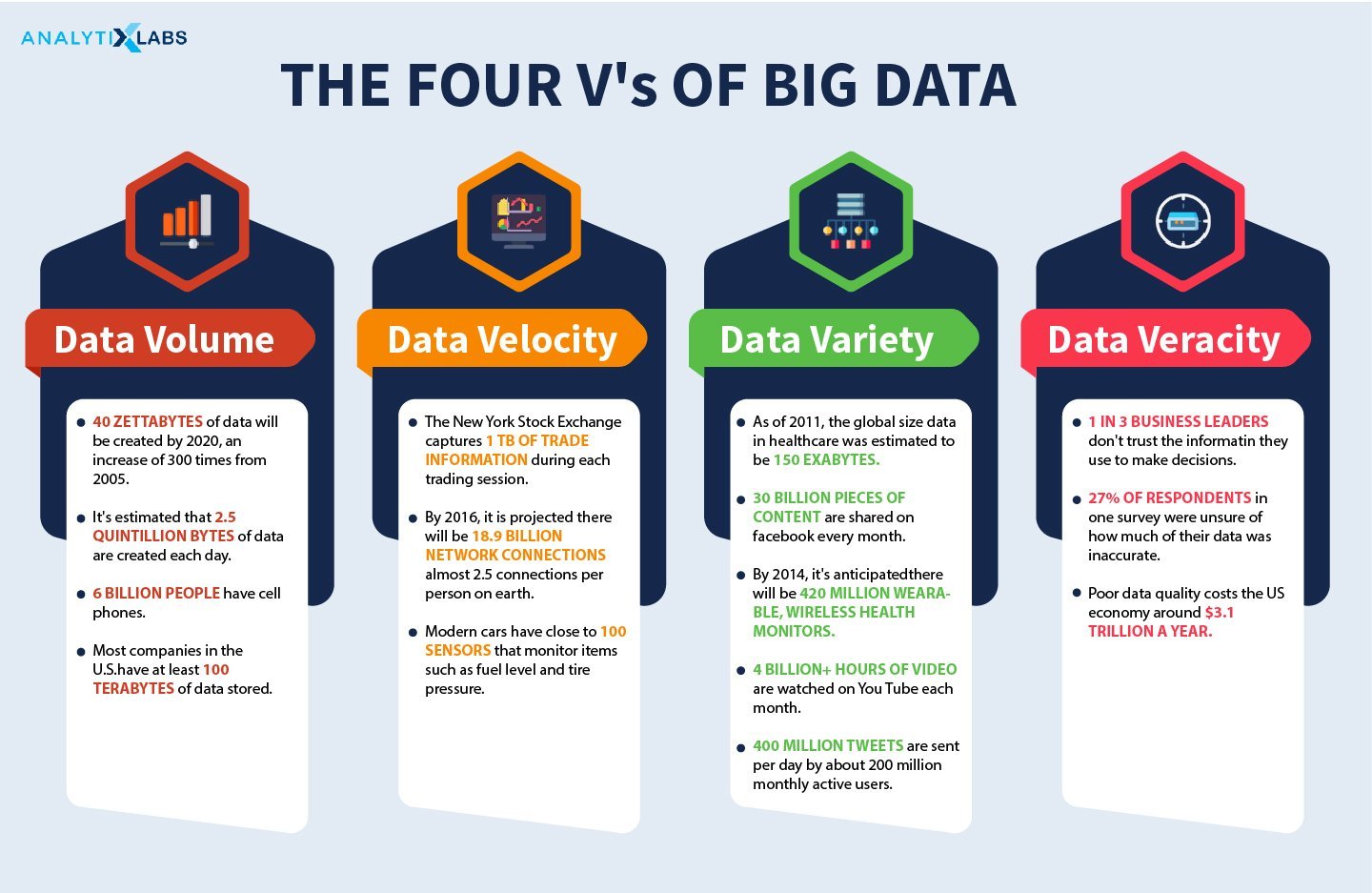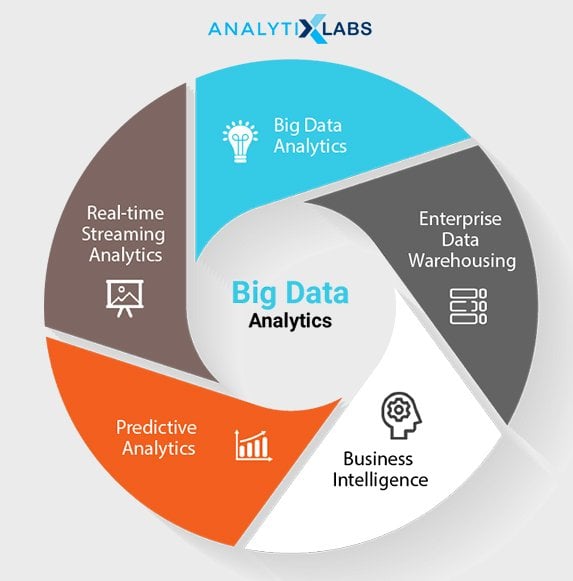Human civilization has progressed to an incredible extent. With the advent of modern technology and the invention of various advanced equipment and devices, almost everything has come within our reach. The Internet has become the most popular platform where billions of users interact and share data daily. With so much data all around us, the importance of Big Data Analytics is rapidly increasing, and it’s becoming one of the most prominent domains across every industry.
Data has become a quintessential part of the business and technology sector in recent times. With huge amounts of data available all around us, businesses, and researchers in the field of technology are constantly working on how to use this data most appropriately. That being said, the analysis of this data can help gain useful insights and make important decisions regarding a business or any technological improvement.
First, Let’s Elaborate On Big Data
When one talks about data analytics, the primary question asked is – What is Big Data?
Big data basically refers to a large volume of data, both in the structured and unstructured form. The importance of Big data analytics has grown into an essential function of several businesses all across the world. The uses of big data for a certain business is extensive and versatile. It is gaining momentum in recent times as most businesses realize the importance of data analytics.
The insights gained through the analysis of big data help make important and strategic business decisions and effectively help an enterprise gain a competitive edge. This helps to outperform its competitors in any industry successfully.
Although it might sound simple, big data analysis involves a set of complex processes to examine large and varied arrays of data. This is done to understand and highlight trends, patterns, correlations, hidden connections, preferences, and other dominant insights and information within a particular data set.
With a proper and optimized approach towards big data analysis and the use of the appropriate data science tools, organizations can derive useful insights from huge corporate data tools and use them to their advantage.
Big data and its importance are visible in making strategic decisions for business development. It is one of the most effective and powerful ways to gain comprehensive insight into the market, customers, and competitors. It is, in fact, topping the list of all kinds of business intelligence solutions in 2020.

History of Big Data Analytics: A deeper look into Big Data
Although the term ‘big data’ is relatively new, the concept of big data is something very recent. It has been around for some years. Even during the 1950s, businesses have been using basic data analytics through the use of numbers, spreadsheets, and manual evaluation, to gain insight into the market and understand the ends and preferences that were popular in the market.
The potential of a huge pool in enhancing business growth and development has been realized by entrepreneurs worldwide. This has boosted the popularity of big data in recent times. Recording and analyzing data streams into their businesses is significantly valuable.
Big data analysis offers time-efficiency along with the advantage of a huge source of data and the application of big data analytics techniques. Big data analytics’ speed and efficiency are the key points that have made big data a sensation in recent times. Earlier, businesses would take months of time to make a strategic decision based on data analytics.
And those would generally be future decisions that were achieved through data collection, analysis, and then gaining insights for implementation. In today’s time, the whole process has been simplified and made faster. Through big data, businesses can quickly extract information and get insights for immediate and future decisions.
A Brief History
The term “big data” has been around since 2005, although 90% of all the available data was created in the past couple of years. While data analysis could be traced back to 7000 years ago, during the Mesopotamian Civilization, the importance of big data analytics in today’s time is still being researched and explored. Although, the first major data project was created in 1937 and was ordered by the President of the USA, Franklin D. Roosevelt’s administration.
The very first data processing machine evolved in 1943. It was primarily invented by the British to decipher Nazi communication codes during the Second World War. The NSA (National Security Agency) was established in 1952 and within the span of a decade. It consisted of over 12000 cryptologists who worked as data analysis experts.
Switching to 2005, right after the coining of the term Web 2.0, the term Big Data was coined by Roger Mougalas of the O’ Reilly Media. Ever since its inception, Big Data has been one of the most popular business intelligence solutions. Being incredibly voluminous, managing, and processing big data with traditional business intelligence tools is nearly impossible.
In the past decade, there has been a sprouting growth of big data organizations. These companies have been using advanced technology, equipment, and proficient data scientists to provide big data analytics services to businesses worldwide. As businesses understand big data and its importance, more and more businesses are shifting towards the field.
Several large companies have already adopted big data analytics for advanced market research and business management through useful insights and information. Big data also forms to be the foundation of important and effective business strategies and decisions.
That being said, big data is in for a long time now. It is yet to be properly explored and utilized, and all of its potentials are still to be exposed. Big Data Analytics is the next big thing that every business owner must be aware of and utilize for the best results and optimal business growth.
When looking at the progress of Big Data ever since its inception, it can be divided into three major phases.
Phase 1
The origin of big data and analytics is from the longstanding field of database management. Big data and analytics at this stage were heavily reliant on data storage, extraction, and optimization techniques.
Ranging from 1970 to 2000, Phase 1 of Big Data Analytics had data management and data warehousing at its core. This phase is the foundation of modern-day big data analysis. Modern big data analysis, which is more about advanced techniques like database queries, online analytical processing, and reporting tools were sourced from the initial phase 1.
Key features
- Data management and data warehousing
- Online Analytical Processing
- Data mining
- Statistical analysis of data
Phase 2
The second phase of big data and analytics began in the early 2000s. With the advent of the Internet and the Web, there came unique data collections. A wide range of data became available, along with improved data analysis techniques and opportunities.
With the rise of web traffic and online stores, several companies started to analyze customer data and preferences to analyze market behavior and trends. This was done by analyzing click rates, IP-based location, and search logs. As soon as this started, a whole new range of opportunities was seen in big data analysis.
HTTP based web traffic presented a huge array of structured and unstructured data that could be used for big data and analytics. While the standard forms of data were still in place, new forms of data had evolved, and businesses now searched for storage solutions and advanced analysis techniques.
Further, the growth of social media also demanded the use of the right kind of big data analysis tools, technologies, and analytics techniques to extract meaningful information and useful insights from a huge pool of unstructured data.
Key features
- Data extraction and retrieval
- Opinion mining
- Social media analysis
- Web analytics
- Web Intelligence
- Spatial-temporal analysis
Phase 3
While web-based unstructured data is still the key to big data analytics, the modern or the latest phase of big data is more than that. Mobile devices have been added to the list of data sources and provide incredible possibilities in the big data field.
The importance of big data analytics of mobile device-based data sets is immense. From location-based analysis to the analysis of search and queries made by a mobile phone user, everything can be analyzed to gain useful information.
From getting behavioral data to health-related data, movements, physical behavior, and a lot more can be analyzed for useful information. The new phase of big data brings us a new range of opportunities.
Secondly, sensor-based internet-enabled devices are a new invention and inclusion in the phase. The Internet of Things is one of the key aspects associated with big data and analytics. Some of the key devices that are generating data with the help of IoT are:
- TVs
- Thermostats
- Smart Watches
- Refrigerators
- Home lighting systems
- Music systems
From data generation to optimization of services and products, businesses have much to gain from modern-day big data analytics techniques and technologies.
Further on, we have discussed the key points of big data and big data analytics. Understanding big data and its importance and knowing the uses of big data is essential. It will help better understand the subject and enumerate ways of implementing big data analysis for time-efficient and cost-effective results for a business.
Key features
- Mobile data generation
- Location-based analytics
- Person centric analysis
- Sensor-based devices for data generation
- Human-Computer interaction
- Mobile visualization
Related: What is Big Data Engineering? Role, Skills, Job & Salary
The Uses of Big Data Analytics
The data analytics field is vast and extremely versatile. Big data may be structured or unstructured and are usually huge volumes of data that need to be processed. As said by some Data Management experts, big data is ” huge overwhelming amounts of information.”
Big data has been a form of a revolutionary concept in recent times. It is being used by several businesses and industries all across the globe. We are currently living in an age of information, and quite likely, data is the most valuable thing for businesses right now.
While most businesses are using big data analytics across various industries, let’s take a look at some of the key sectors of big data and analytics are being proactively used.
- Healthcare
- Fashion
- Consumer products
- Cybersecurity
- Music
- Media
- Television media
- Scientific research
- Utilities
- Ecommerce
Apart from these industries, data has become a valuable item for almost every industry. Ranging from trends, market analytics, user preferences to competitor analysis and business analysis, the importance of big data in every field is undeniable.
With the growing popularity of the Internet and mobile devices, data generation’s volume and speed have incredibly increased. According to statistics, the total amount of data present in the world in 2013 was 4.4 zettabytes. This number is set to climb to 44 zettabytes by 2020. To simplify the numbers, 44 zettabytes is equivalent to 44 trillion gigabytes.
While realistically, it is impossible to process and analyze that much data, even with all the modern techniques and technologies, why big data analytics plays a major role is because it makes it partly possible. The need to process the large unstructured data sets was imminent, but the traditional data analysis techniques were insufficient. This is what brought big data analytics into the scene.
Talking about the importance of big data analytics and why big data analytics has grown to be so important in various sectors, let’s look at some of the key sectors where big data is being used extensively for useful information and insights multitude of other applications.
1. Academia
With the recent Coronavirus pandemic and the entire education system shifting slowly to the online platform, big data and analytics have grown to be even more important for the field. Big data analytics is instrumental in enhancing education in today’s time. Big data and analytics help academic institutes optimize their services and provide more intuitive and useful digital courses to students.
With numerous educational courses being available on the Internet, big data helps academic institutions analyze market trends and statistics and gain a competitive edge.
2. Banking
Big Data Analytics has been a huge help for bankers. The key utility of big data in the banking sector is to detect fraud. Along with that, it also helps prevent any fraudulent activities in real-time and also helps finance companies and institutions get adequate information about the history and overall customer behavior of a certain loan seeker.
It is also being used to prevent misuse of credit/debit cards, fraudulent online transactions, archiving inspection tracks, errors in customer stats, and a lot more.
3. Healthcare
One of the most important sectors where big data plays a key role is in the healthcare industry, including medicine. Big data analytics is crucial to the field because of the field’s requirements, which include an extremely precise and wide range of data or information that can only be obtained through big data and analytics.
With predictive analysis, patients can now get personalized healthcare services. This is possible with the help of big data analysis and its application in the field. Along with that, other things associated with big data are:
- Telemedicine
- Remote monitoring
- Fitness trackers and wearables
4. IT and Manufacturing
Both the IT and Manufacturing fields have a lot to gain from big data analysis. The importance of big data analytics in both fields is grave. Ranging from supply strategies, a quality assertion of products to creating a transparent and functional infrastructure, Big Data is crucial to the manufacturing industry and is being increasingly used.
IT firms are one of the largest users of Big Data. Big data analytics is important for IT because it provides the required information to optimize functioning, operations, enhance employee productivity, and effectively manage risk.
5. Retail and Transportation
The retail industry has also been using big data analytics extensively. With the transformation and modernization of both the retail and transportation sectors, data analytics have also become a part of the process. Local demographic surveys, POS scanners, RFID, customer loyalty cards, smart sensors, and store inventories are some of the popular data generation sources.
Data technologies are useful to the transportation industry to optimize routes, reduce costs, control traffic, manage road congestion and traffic jams, drive technological innovation, enhance logistics, and gain a competitive edge.

Characteristics of Big Data
While there are several definitions of big data, the four key characteristics of big data, which also answers the question – What is big data analytics, are:
- Volume
- Variety
- Velocity
- Veracity

1. Volume
Volume is the amount of the data and the form of data being taken into consideration. Data is collected from many sources. Business transactions, web, mobile, social media, sensor-based devices, and machine-to-machine data are common forms.
2. Variety
Data is generated and also extracted in a variety of forms. Ranging from structured and unstructured data, the categories can be further divided into detailed datasets. Numeric data in traditional databases, unstructured text documents, emails, videos, audios, stock data, and financial transactions, along with all other forms of heterogeneous sources of data, falls in this category.
3. Velocity
Data, in modern times, is generated at an incomprehensible speed. This unprecedented speed of data streams brings in the need for big data analysis with the appropriate technologies, data science tools, and competent data scientists. RFID tags, smart metering, and sensors drive the requirement of dealing with this high data generation speed in real-time.
4. Veracity
In Big Data, this is perhaps the most important V in the Analytics context. The term veracity, in general, refers to the accuracy, truthfulness, and consistency of the information. Here, it refers to the noises, irregularities, outliers, biases, and anomalies in the data. For any meaningful analytics outcomes, the Big Data must be processed are treated to minimize the veracity issues. It is a prominent challenge of Big Data and must be accounted for in any Big Data project.
For more details, you may also like to read: Characteristics of Big Data | A complete guide
Types of Big Data
Along with that, big data can be classified into three categories by type:
- Structured
- Semi-structured
- Unstructured
Structured Data
Structured data is the kind of data that can be processed, stored, and retrieved in a single and fixed format.
Semi-structured Data
The kind of data that is not classified into any particular database is known as semistructured data. It can contain vital and important elements within its range.
Unstructured Data
This type of data has no form or structure. It is completely unarranged and can vary in form, content, and source.
Importance of Big Data
Big Data and Analytics are of immense importance to businesses all across the globe. Big Data helps businesses across various industries to identify business opportunities, market trends and gain useful insights about customer preferences to optimize their operations and services.
Big data analytics is the key factor that contributes to business development and streamlined growth in modern times. Several businesses are using big data to increase the value of their firms and provide better services. Here are the key points why big data analytics is important for businesses all across the world.
- Unlimited source of data that can provide a wide range of information
- Cost reduction for businesses
- Useful insights and market analytics
- Faster and more efficient decision making
- Strategizing business operations
- Launching new products and services
- State of the art business intelligence solutions
- Modern-day element to beat the competition

FAQs – Frequently Asked Questions
Q1. What is Big Data Analytics in simple words?
The analysis of a huge pool of structured and unstructured data to gain information.
Q2. Why big data analytics is important?
Big data is important as it provides the most appropriate and useful information and insights relevant to business across various industries.
Q3. How is Dig Data stored?
It is stored in specially designed and encrypted devices, business servers, and other assorted storage locations.
Q4. What is Big Data Technology?
Big Data Technology is the technology of analyzing big data to derive and extract useful information and insights about a certain topic.
Q5. What skills are needed for big data?
For big data careers, you need relevant data science knowledge, data analysis skills, advanced knowledge in coding languages, and comprehensive data management skills. You may also like to read: Big Data Job Opportunities and Trends | Career in Big Data
Big Data Analytics in Our Modern World
Finally, Big Data Analytics has revolutionized the field of data management and analysis and redefined the presence of data in the modern world. It has become one of the most important elements for business development in today’s time.
You may also like to read:
1. In Simple Terms, What Exactly is Big Data in Artificial Intelligence?
2. What is Big Data Architecture, Its Types, Tools, and More?









2 Comments
This is a great detailed article on data analytics, amazing work
Amazing Blog. Thank you for sharing this information.